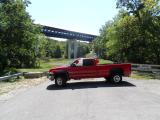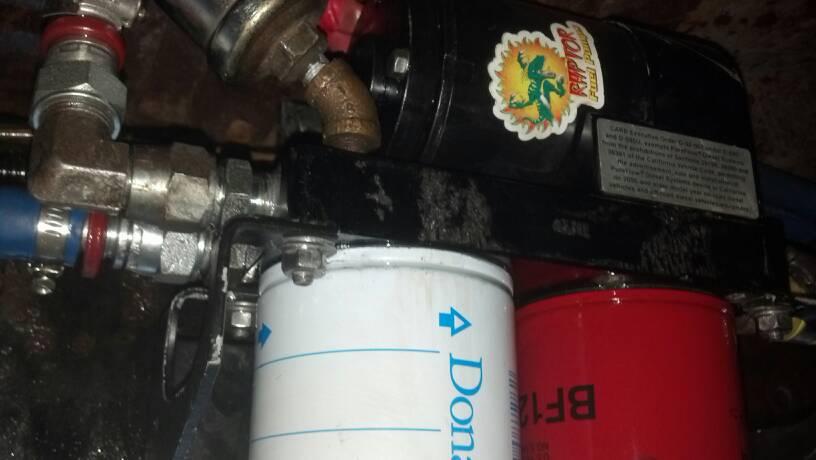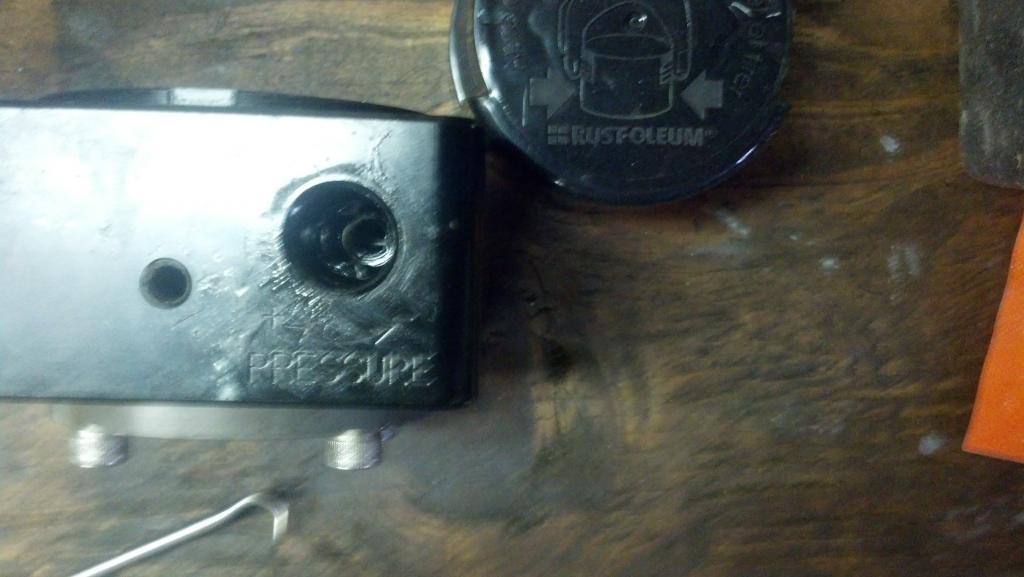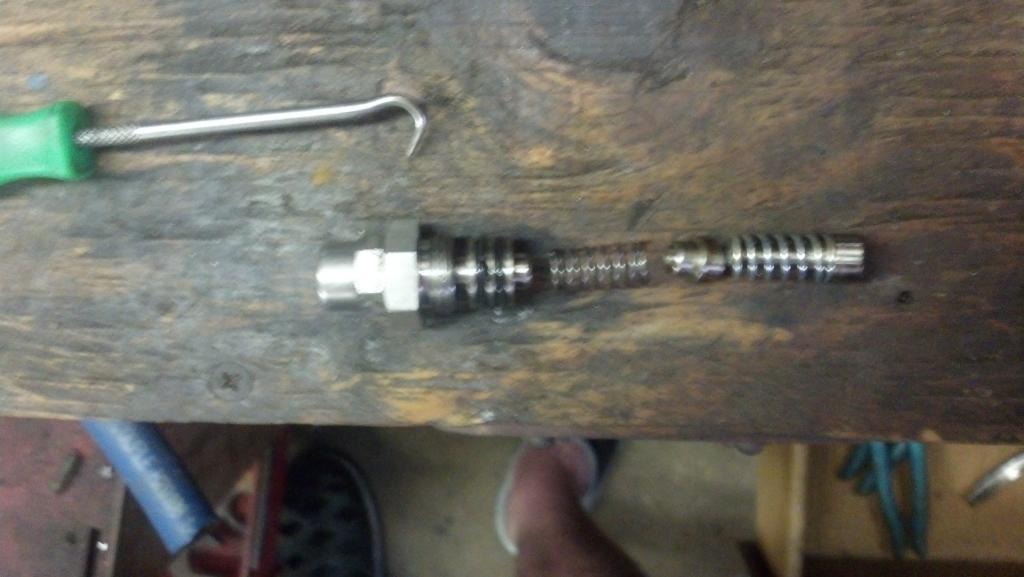Everything posted by diesel4life
-
Advice for long trips as vacations.
Unfortunately I don't even have any pictures at the moment, I had them on my phone along with about 600 other pictures and it ended up in Lake Erie a month or so ago. I KNOW I had all my pictures saved to a cloud drive, but cannot retrieve them. It's been a real bummer because I have been using my camera phone as my primary camera for years and lost out on a lot of good memories.... Back to the wheel bearing, it's pretty straight forward. You have to remove the bearings from the truck, and the hole will be drilled on the top of the flange, and centered. This allows the grease to be distributed on the outside of the bearing (You will have to rotate the bearing as you grease) The important part is to take your time and don't drill too far. You will know when you push through the housing of the hub, that is all the further you want to go. I used a pencil magnet to get all the shavings out, this is another important step. I also put the shop vac up to the hole to try to suck anything out the magnet may have missed. When tapping I coated the tap with grease and then swabbed the hole with the magnet a few more times. On trucks like mine with the rotors and hubs pressed together with the studs, you will have to use a 90* grease zerk and point the fitting towards the inside of the truck. A hole app. 1/2" (big enough to fit the grease hose through) will have to be drilled through the spindle so that you can access the grease zerk from inside the wheel, next to the universal. This may not be necessary with slip on rotors, you may be able to simply remove the rotor to access the zerk. This is something that in all honesty probably only needs done every few years depending on how many miles you drive and if you are in the mud and slop frequently. You definitely don't want to over grease them and blow the seals.... When I drilled and tapped mine I had pulled them to change my rotors. In the process of trying to pull the hubs from the truck, I separated both hubs. The outer half came with the rotor and the inner remained frozen in the spindle. Everyone I talked to said they were ruined at that point and I would have to buy new. Not wanting to shell out big coin on two hubs and having nothing to lose, I figured I would play around with them. Being able to see the insides of one helped me choose the spot to drill them, I cleaned them up and pressed them back together with a 50 ton press. Then I drilled and tapped and greased them. My hubs were pretty low mileage (about 75k) but at 13 years old there was not that much grease left in them. I pumped 20 shots into each hub while spinning them to distribute the grease evenly.Getting pictures will be kind of tough without pulling everything apart but I will do my best to get a few in the next day or so if your interested....JR
-
Terrible luck with Raptor.
I think you would be wise to relocate it to the frame rail. Vulcan Performance sells relocation kits or you can piece it together yourself if you have the recources.JR
-
Poll..........To buy.........or not to buy?
I think you've pretty much answered your own question. This is what I would do, and probably keep it until it requires more maintenance than it is worth and then tear it down and scrap it. If you sell the drive train and scrap the rest you should be able to recoup the costs. If it were more long term, I would probably consider a good used dump trailer, but anytime you can get some use out of a piece of equipment and get your money back when it's all said and done is a good day to me. JR
-
Do I need to retain my fuel heater?
It's simply a matter of cutting your 3/8 or 1/2 fuel hose down (whichever you ran) and adding the proper fitting to tie into the canister, then run a big line kit from canister to VP. Vulcan Performance sells any and all fittings you could ever need to do whatever you need to do ;) JR
-
Advice for long trips as vacations.
Tom, that may be correct on a 2wheel drive truck (I've never worked on one) but on 4 wheel drive trucks they are torqued. I can't remember the spec, but it is up around 150-180 ft lbs IIRC. The socket is actually a metric size but I use an inch and 3/4". It is a tad sloppy, I believe an inch and 11/16 would fit better but it's what I have and works for me. One of the best preventative mods I have done is tap my hubs with a grease zerk so that I can grease my hubs every few years. They were nearly dry when I had them apart a few years ago so they were most likely on borrowed time. BTW, a 2 wheel drive truck in Minnesota...:eek: You sir, are a brave soul!! JR
-
Do I need to retain my fuel heater?
There is no reason to delete your stock canister IMO. You can run whatever fuel pump you choose and still run through the OEM set up. Just think of it as an extra filter and added insurance. Plus you will retain the water in fuel sensor to alert you of any potential problems. As for the heater itself, I have heard of a few instances in sub zero weather where not having one has left people stranded, but I believe it has to be pretty extreme weather. Being in Montana you could possibly see it get cold enough to cause a problem. JR
-
Biodiesel at ARCO
My cousin burns over 1000 gallons of B20 a month on all the farm equipment and trucks and has never had a problem. He recently had to rebuild one of the engines out of his 966 and the injectors were clean as a whistle. JR
-
Exploded View Of a Bosch VP44 pump
:o. Coming across this post I realized I dropped the ball on shipping that pump to you, Mike. I have 2 days off at the beginning of the week, I'll be sure to get it shipped out to you. BTW, part #37 (a small 2 bolt cover) was the million dollar part on my former 00. The guy I bought it from said the VP was leaking fuel, and "when they leak fuel out the back of the pump they need rebuilt" :confused:OK, so I picked up the truck for $1800 on the assumption it needed an injection pump. Got it home, got to looking at the back of the pump with a mirror and saw what looked to be a hair line crack running across that little cover. So after buying a tamper proof torx bit to remove the 2 screws, I proceeded to remove the cover. Got the first screw out and while breaking the 2nd screw loose the cover literally broke in half. I ground a V in both halves of the cover, TIG welded it back together, bolted it back up, bled the fuel system, and she fired right up. I put close to 100k on that truck.....on that injection pump :cool:JR
-
W&F hauling stuff.
So the 48 doesn't have the ability to lock out OD? What does the TH mode do?
-
Need a help with Raptor pump...
The thing I don't like about the mechanical pumps is there is no practical way to run any additional filtration beyond the OEM canister. From what I have read, any filtration is required to be added downstream of the pump which eliminates a twin filter set up on the frame rail.
-
Terrible luck with Raptor.
I proved a while back that the Raptor uses the same motor as the AD100, yet the AD100 seems to suffer a lot less problems than the Raptor. So what are the differences? The AD100 is mounted on the frame rail as opposed to the side of the engine and is not subjected to constant heat and vibration like the Raptor is. The AD100 also pulls through the f/w seperator before any fuel travels through the pump so there is no chance of anything plugging up a screen or gear. The AD100 pushes fuel while the Raptor has to pull it. Pumps are more efficient and designed to push fuel. Also when one installs an AD100 the fuel lines are almost always upgraded to 3/8 or 1/2". Those small OEM fuel lines are way too restrictive for a pump to pull fuel 10+ feet through IMO. I would be willing to bet a fair wager that by simply relocating the Raptor to the frame rail, upgrading to 3/8 or 1/2" fuel lines, and possibly installing a catch all fuel filter (nothing too restrictive) the Raptor pump would suffer A LOT less failures. :thumbup:
-
ATV issue...
Pull the spark plug, what does it look like? What if you straight up pin the throttle (any gear) does it fall on it's face?
-
Truck with rust ....... thoughts
Panels can be replaced fairly easily by a competent shop, those aren't /wouldn't be so much of a concern to me. What I would be more concerned with is frame condition and floor boards. That's where things can get real expensive to try to repair/replace. I would ask for a few shots from the underside looking up if you haven't already. Any kind of repair of the body panels will most likely only be temporary, as mentioned above most rust starts from the inside out and no amount of sanding, grinding, blasting, or rust proofing will cure that unless the panel is removed and treated from both sides. And if you are going to that extreme, you would be time and money ahead to just replace the panel rather than try to repair it. 1000 HP truck That is impressive! What gen truck is this?
-
Dead pedal, codes, and bad news from tests - please help
Is the Timbo APPS the one that you supposedly do not have to calibrate? I guess my question is, if it required calibration, did you follow the steps properly? How about battery voltage? Your not over/under charging your batteries while the truck is running?Anytime I see improper voltage like you are seeing I try to eliminate the possiblility of a battery/altenator malfunction or poor ground connections before condemning any components.
-
Makes no sense.
The AD100 is the same as the 150. They both have fuel returns and dump excess fuel back to the tank. The Raptor set up simply "blocks" the flow of fuel with the adjustable regulator, no return line to the tank. I have wondered if that could be part of the reliability issues with them because the more you decrease the pressure to the injection pump, the more you are restricting the flow of the pump, essentially dead heading it so to speak. I believe the 100's and the 150's have a little better set up because the pump is always unrestricted, whatever doesn't go to the injection pump gets dumped back to the tank. The pump does not have to work as hard this way.
-
Can't explain my drastic mileage increase
Running different tires on either the truck or trailer? Any recent mods?
-
"built" 47RE woes
You may not have fixed it, but you stuck with it and figured it out. I was looking at the first post, you've been dealing with this problem for over a year! I gotta commend you on a job well done, Rick.
-
I have been learning a lot on this site
Hello Wade, welcome to the forum!
-
Makes no sense.
With the Raptor pumps they are putting out a constant pressure and all your doing by adjusting the regulator is either opening up or closing off the flow of the fuel. I only ran a Raptor for a little over a year before I converted it to an AD100 frame but my pressure was always steady. Make sure your regulator is locked down tightly because vibrations could cause it to loosen up over time. The only other variation I can think of other than a plugged inlet would be the motor varying in rpm. I've had mine apart and I can tell you the brushes are very cheap.A few pics of the Raptor regulator
-
Automatic Treans Service.... What is best....
Here is a good write up on changing your trans fluid. Simply dropping the pan only nets around 4 quarts, doing it like described in the write up will get you closer to double. On top of that, I allowed it to drip over night and netted another 2 quarts or so for a total of approximately 10 quarts. It's a bit time consuming, but IMO getting as much drained as you possibly can is important. http://www.genosgarage.com/faq.asp Scroll down until you see the link for changing the trans fluid. It is in pdf and I couldn't link it directly.
-
Rookie question on Dana 70
Just a little light humor, I meant nothing ill in any way. Good luck getting it back together, let us know how you make out!
-
Help: in-line fuel filter??
Are you sure your lift pump will pull through that system? I'm pretty sure those are designed for a pusher system, especially since they're in the 6.7 Category.
-
Rookie question on Dana 70
A quick peek down the length of the tube with a flashlight will tell you if you have any obstructions or not. I can't think of anything that could be preventing them from sliding in, you may not be getting the correct angle.Maybe a little hair would help.....
-
Towing with the electric fan conversion kit's for '02
Those temps sound normal for fan operation so I would guess at this point it's probably working fine as long as it isn't engaging below 200* I have checked my temp gauge against a manual and it was within 2 degrees. From the temps your reporting when the fan is engaged, I would wager yours is pretty close.
-
Towing with the electric fan conversion kit's for '02
First things first, if your rad is plugged I would remove it and degrease it. From the sounds of it your fan may be functioning fine. It's fairly normal to hear them engage momentarily upon start up. When you say it will run non stop while towing, how hot is your gauge showing? This could possibly go back to a plugged rad and the fan may be functioning as it should. As for the a/c maybe putting some dye in the system can help you pin point your leak. I found a good online source for a/c components, priced cheap, good warranty, and I've been very happy with everything I've bought from them. I'll dig up the link and post it up. http://www.discountacparts.com/ These guys offer reman, new in house brand, and new oem depending on your budget, with no cores and free shipping.






